Custard Apple is a delicious sweet subtropical and delicious fruit. It is also known as Sitaphal or Sugar Apple. We discuss the top 16 steps to boost Custard Apple yield below.
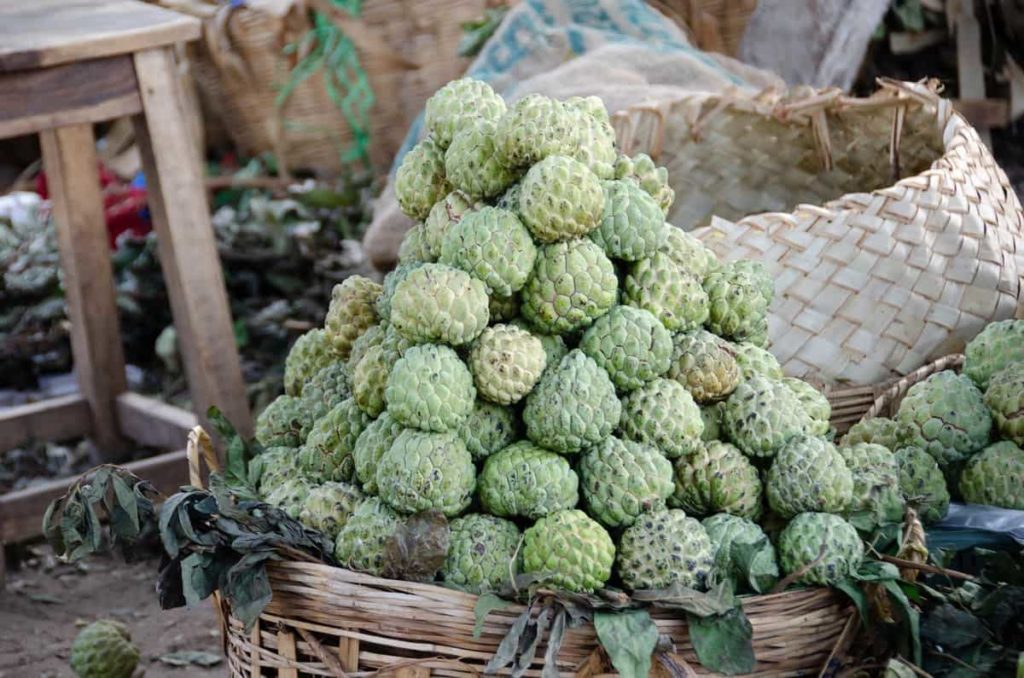
Top 16 steps to boost Custard Apple yield
Step 1: Factors affecting Custard Apple yield
Irrigation in the dry season and once ripe will increase fruit size. Custard Apple yield depends largely;
- Variety
- Tree age
- Climate
- Soil
- Irrigation
- Management practices
Step 2: Select Custard Apple varieties
Some Custard Apple fruits are small and have many seeds with very little food. On the other hand, some Custard Apple varieties produce large fruits with only 5-7 seeds and enjoy all the flesh. There are mainly two types of Custard Apples; both are sweet, juicy, and tasty. Just cut them in half, take out the flesh with a spoon, and enjoy.
Pink Mammoth (also called Hilary white): Fruits are very large (up to 3 kg) of high quality, and their seeds are very small, almost less than seeds. It is the most popular type of commercial Custard Apple production. African Pride: Fruits are smaller (500-800 grams) and have more seeds than Pinks Mammoth. They begin to bear fruit first.
Custard Apple trees are grown from seed, and there is slight variation in the plants within a particular selection, for example, ‘Thai Lessard,’ ‘Kampong Mauve.’ Therefore, several choices have been introduced, including ‘Thai Lessard’ (a green variety), ‘Purple’ or ‘Red,’ ‘Kampong Mauve’ (purple-red varieties), and a seedless variety known by various names, ‘Cuban Seedless’ and ‘Brazilian Seedless.’ Fruit without seeds split when they are near maturity, and the quality and yield of the fruit are said to be inferior to that of the seed varieties.
Step 3: Climate requirement for improving fruit set
The tropical climate is ideal for Custard Apple blossoms. Dry, hot, and humid conditions favor growth and fruit set. In cases where mild winter conditions and high humidity during flowering and fruit set can produce a good fruit crop.
In case you missed it: Custard Apple Seed Germination (Sugar Apple/Sitaphal)
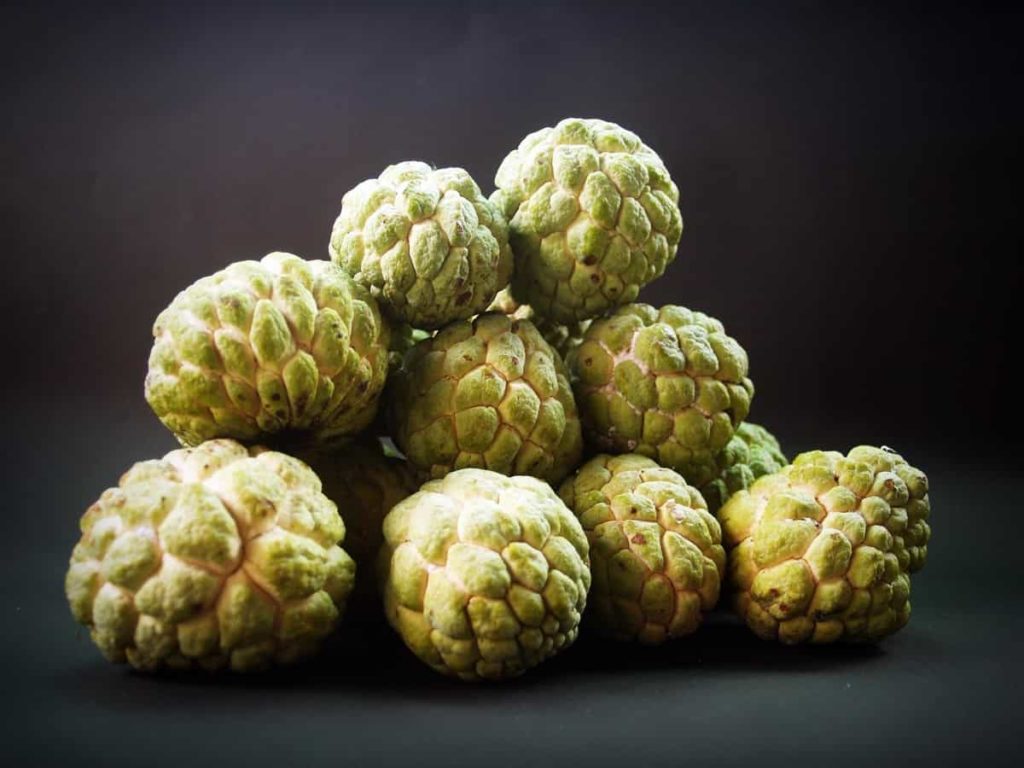
Step 4: Location for fruit growth
The growth of Custard Apples is mainly dependent on the climatic conditions of temperature and humidity. Plant in a warm, wind-free, frost-free, and high-moisture area. At temperatures above 28°C, the tree will produce more growth and less fruit. In contrast, at temperatures below about 13°C during fruit development, the fruit’s skin may become discolored and burst. Avoid dry areas where the relative humidity can be less than 70% during the fruit set.
Custard Apple trees are spread, shaded by large, green bent leaves. The tree produces many light-yellow trumpet-shaped flowers that emit a sharp, sweet scent, especially in the late afternoon when male pollen sacks burst. It prefers tropical climates but with cold winters. As a result, farmers usually grow fruit on hills in barren lands.
However, erratic rains will hamper fruit quality. The tree features yellow trumpet-shaped flowers that emit a pleasantly sweet odor, with only a small number of flowers bearing fruit. In subtropical climates, where the days are not too hot and the nights are not too cold, it takes 20 to 25 weeks for the fruit to reach maturity.
Step 5: Planting season for better fruit setting
Planting is done in the rainy season. Depending on the soil type, pits of 60x60x60 cm at intervals of 4×4 or 5×5 or 6×6 are dug before the monsoon and filled with good quality FYM, single superphosphate, and neem or Karanj cake in dry conditions and drip irrigation. Plants are planted 6×4 meters with the system for good growth and good fruit setting.
Step 6: How to find out when they are ripe
A Custard Apple ripens when you gently squeeze it and give it a little under your hand. Just like an avocado. You can buy Custard Apples that are ready to eat or still hard to touch and let them ripen for the next few days after purchase.
Step 7: Pollination improves tree growth
Custard Apple is technically self-pollinating. Custard Apple trees will bear fruit in 3-4 years. Some breeds begin to germinate at a young age, 1-2 years from seed. Custard Apple trees bloom from spring to summer, producing green-yellow trumpet-shaped flowers that smell pleasantly sweet. For this reason, Custard Apple flowers pollinate the male pollen by hand and the female flowers by pollen.
Collect open flowers and store them in paper bags. They will spread their pollen, apply it to newly opened flowers which are female flowers, and use a small paintbrush. It is best to have two trees to increase the chances of pollination.
In case you missed it: Custard Apple Cultivation Income, Yield, Project Report
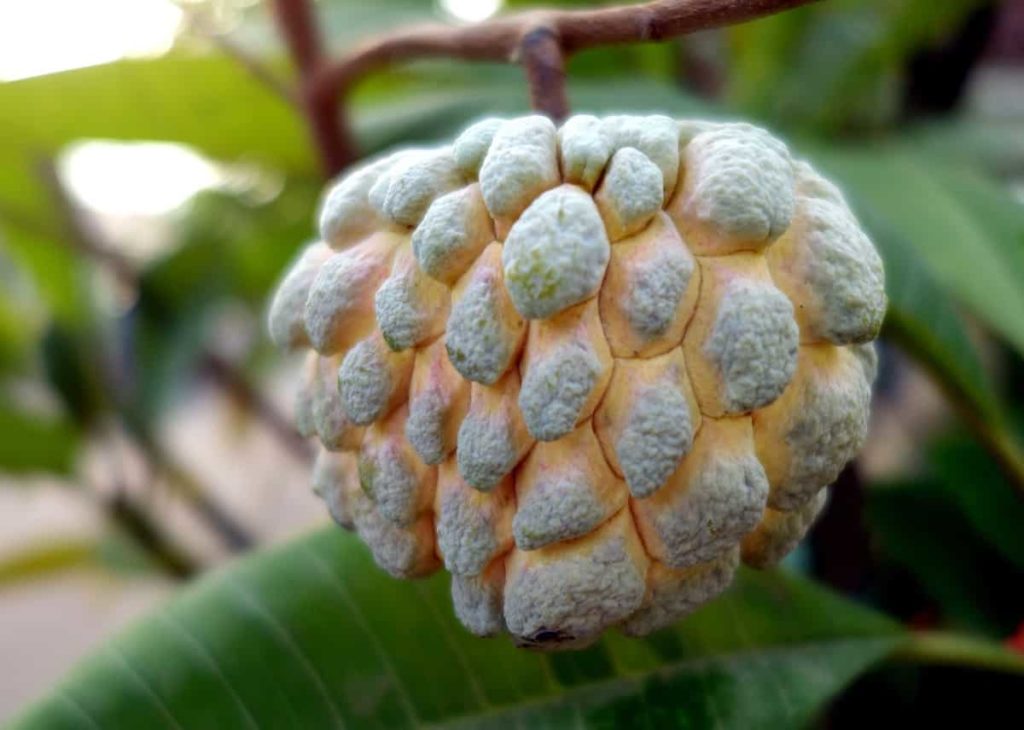
Step 8: Method propagation for improving fruit yield
Custard Apple propagation can be done by seeds and as well as by vegetative methods. Seeds are extracted from quality fruits and used for sowing.
From seeds – Seed germination is a traditional method by which the Apple tree is grown. Seed germination is the most widely used propagation method. However, this method has many disadvantages, such as low germination rate, high genetic variation, late start of the crop, and the plants being tall and difficult to handle.
Collect fully ripe fruit seeds from a tree with excellent yields, taste, and health. Seeds lose their viability quickly (about six months), so they should be planted soon. Seeds should be sown horizontally at a 2-3 cm depth at about 1.5 cm in a quality seed mix. Generally, germination occurs within 30 days. However, its germination rate is low, and time is slow due to hard seed coating.
Grafted tree – Vegetative propagation using grafts is another type of grafted tree propagation. This method is most recommended because it ensures that plants with the same genetic identity have better yields, healthier trees, and quality fruit. If possible, buy grafted trees from the nursery.
Step 9: Fertilizers to increase flowering and fruiting
Use a balanced fertilizer or lemon fertilizer every three months until the tree begins to bear fruit. Then, feed sulfate of potash or camphor tea to enhance flowering. When the plant is big enough to start bearing fruit, fertilize it 3:10:10. It will help in producing more fruits. It is recommended to apply complete fertilizer in the early years of planting. Once the tree is mature enough to bear fruit, 3:10:10, the fertilizer use significantly increases the flowering, fruit arrangement, and harvesting.
As far as organic fertilization is concerned, the Custard Apple responds well to the use of organic matter from its earliest stages of development. Organic fertilizers improve soil texture and condition and facilitate root development. Applying 60 to 80 kg of manure or compost per year is recommended.
Step 10: Control fruit drop and improve fruit size
The following growth regulators are used to control fruit drop, improve fruit size for uniform flowering, and improve fruit size. Ethryl is sprayed at 1000 ppm one month after fruit set to bring the plants under uniform rest. Biocil is mixed in one ml of water and sprayed just before flowering for better and faster flowering. 10 to 20 ppm NAA is sprayed before flowering to reduce flower and fruit drops. During fruit development, 50 ppm GA + 5 ppm + 0.5 ppm cppu, foliar spray improves fruit size and luster.
In case you missed it: Custard Apple Farming Project Report (Sitaphal), Profits
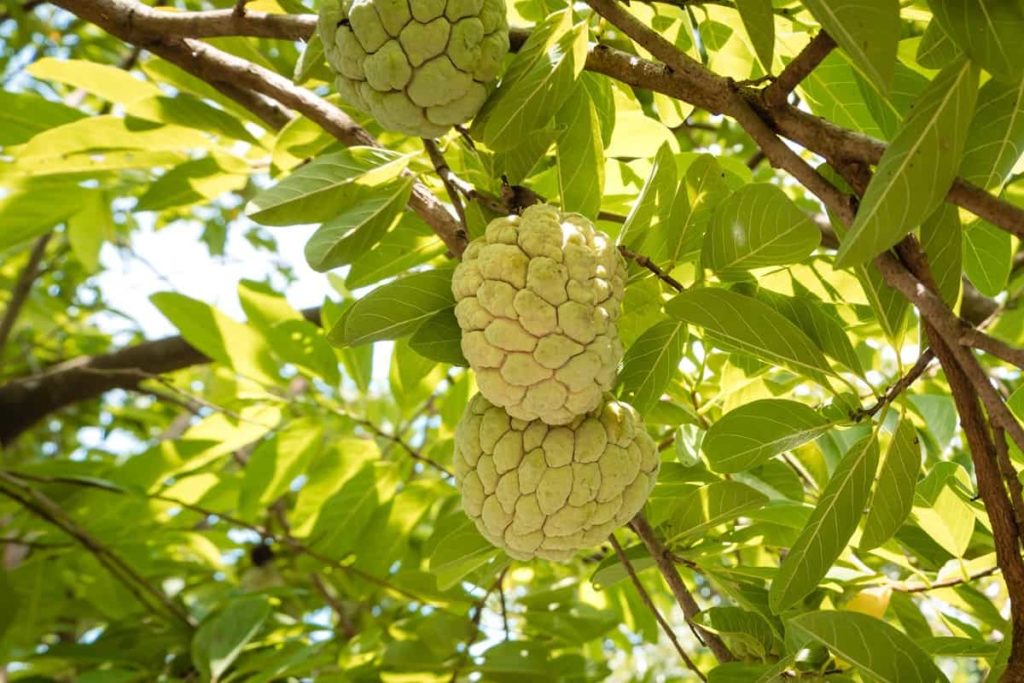
Step 11: Reasons for small black spots in leaves
Insufficient potassium is available to the tree. It is usually caused by potassium, calcium, and magnesium imbalance in the soil. It is more common in light soils with heavy leaching and in trees with heavy crop loads. The yellow color begins at the margin of the leaf and then spreads to the veins. Small black spots form in the affected areas. Adjust the fertilizer application based on the results.
Prevention – Analyze annual leaves and soil to monitor nutrient levels. Apply an adequate amount of potassium fertilizer during the growing season.
Step 12: Regular watering improves fruit growth
Custard Apple tree tolerates only mild drought. This tree needs 700 mm of rain annually to stay healthy. If the tree experiences a severe drought, it may bear fruit inconsistently for one or two seasons. Underwater trees can burn fruit in direct sunlight, while over-watering can cause roots to rot. When the trees become dormant during the winter, they do not need regular watering. Fertilize well after the fruit is set with organic fertilizer. It is important to water regularly from flowering to harvesting.
Custard Apple trees tolerate drought conditions; however, fruit set and size may be smaller and thinner due to drought pressure. The stress of mild to severe drought can reduce the size of Custard Apple fruits by 10 to 50%. Therefore, it is recommended to water the Custard Apple trees from time to time to increase the quality and yield of fruits. It is essential to water from the time of flowering to harvest. The watering of young and mature trees should be reduced during the fall and stopped when most of the leaves have fallen.
Watering mostly leafless trees during autumn and winter can cause root rot and damage tree strength and health. Custard Apple is commonly sown as a rainfed crop. It is advisable to provide irrigation before flowering and fruiting. The plant can be watered till monsoon. The mist sprinkler irrigation method is more suitable than flood or drip irrigation. The technique of mist sprinkling has been chosen because it can lower the temperature and increase the humidity, promoting the activity of flowers and fruits.
Step 13: Pruning and thinning improve the quality and yield of fruits
Custard Apples are a weighty fruit and can reduce the weight of the branches of this tree. You want to trim the branches from behind to establish strength during the idle period of the tree. The operation could be even more severe if it involves removing two-thirds of the growth from the previous year. In commercial farming, pruning and thinning are critical to good-quality fruits. The thinning process reduces the number of fruits per tree while improving the fruit quality.
In case you missed it: Custard Apple Farming (Sitaphal), Planting, Care
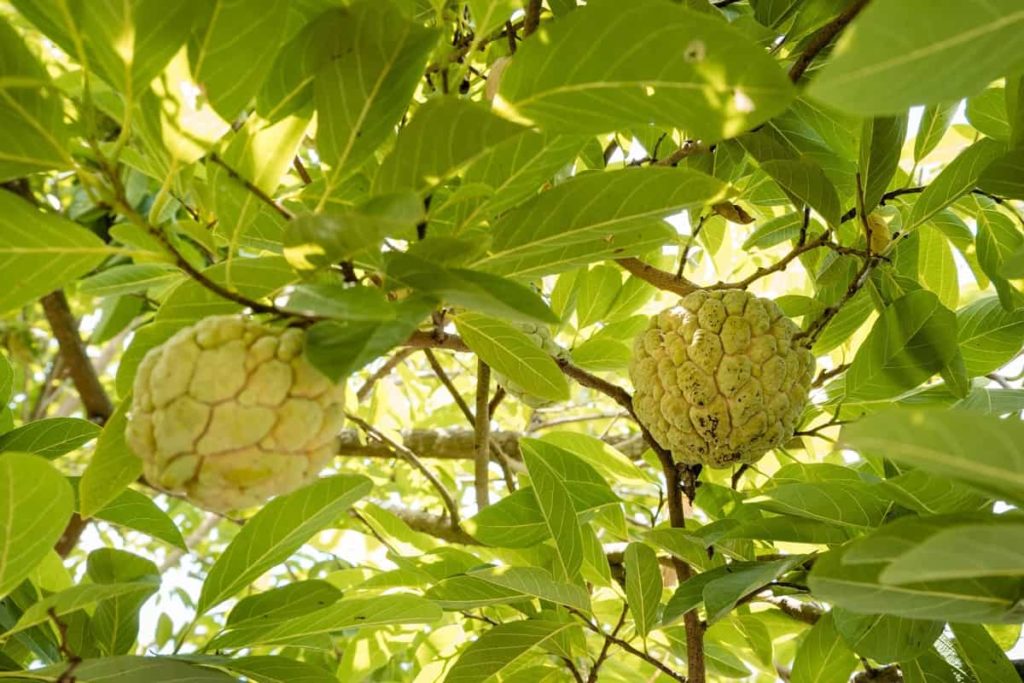
In commercial cultivation of Custard Apple, only 50 fruits per tree must be allowed. Thinning all the small fruits into clusters leaves only one or two fruits, increasing the quality and size of the fruit. However, it dramatically affects the price you can demand and thus the profit. Custard Apple tree pruning should be done only in spring if you are in a cold climate. Custard Apple trees make many branches, so pruning is recommended to train the tree in the desired shape and manage the number of essential branches.
Careful tree pruning works to maintain the balance of the tree structure. Similarly, it would help if you did sanitary pruning after each pruning. Renewal pruning is done after about ten years when the tree is old and its strength and yield are low. In regenerative pruning, the tree must be pruned firmly but, in several stages, to start growing again.
Step 14: Intercultural operations essential for crop growth
Young Plant Care: The gap should be filled as soon as possible. Replace dead or weak trees to fill gaps of the same age. Weed control and intercropping: To keep the farm clean, you should remove them regularly and make a grass-free field. Shallow planting and tree basins can be cleaned between rows. Also, you can earn some income by intercropping with some short-term crops like;
- Legumes such as Green Gram, Black Gram, Red Gram, etc.
- Peas
- Beans
- Herbs
- Marigold flowers
Mulching – It can be done around the plant base for maintenance. It can also prevent soil erosion. Paddy straw, coconut straw, etc., can be used for mulching. Nowadays, commercial farmers are using plastic mulch that you can get in the market.
Step 15: Pest and diseases control to increase crop yield
It is native to the tropics and comes with its unique disease risks. Before the Custard Apple tree, black canker, leaf spots, and some nematodes on the young are quite a problem. The pests and diseases control in time are necessary so that the crop can give a good fruit yield. Custard Apple trees are less susceptible to pests and diseases. However, you should be aware of the safety of plants in case of any disease attack. Trees may be affected:
- Anthracnose
- Mealybug
- Scale insects
- Fruit boring caterpillar
- Leaf spot
- Black stone
Proper chemical control is advised. Weed control should be applied if you are cultivating organically. It is recommended to spray with neem oil. Your local horticultural department will be a great source of information on pests and diseases in Custard Apple cultivation. Do not try or experiment without knowing the symptoms and causes of pests and diseases.
In case you missed it: Fertilizer Management for Apple Trees: Organic, Compost, NPK, and Schedule
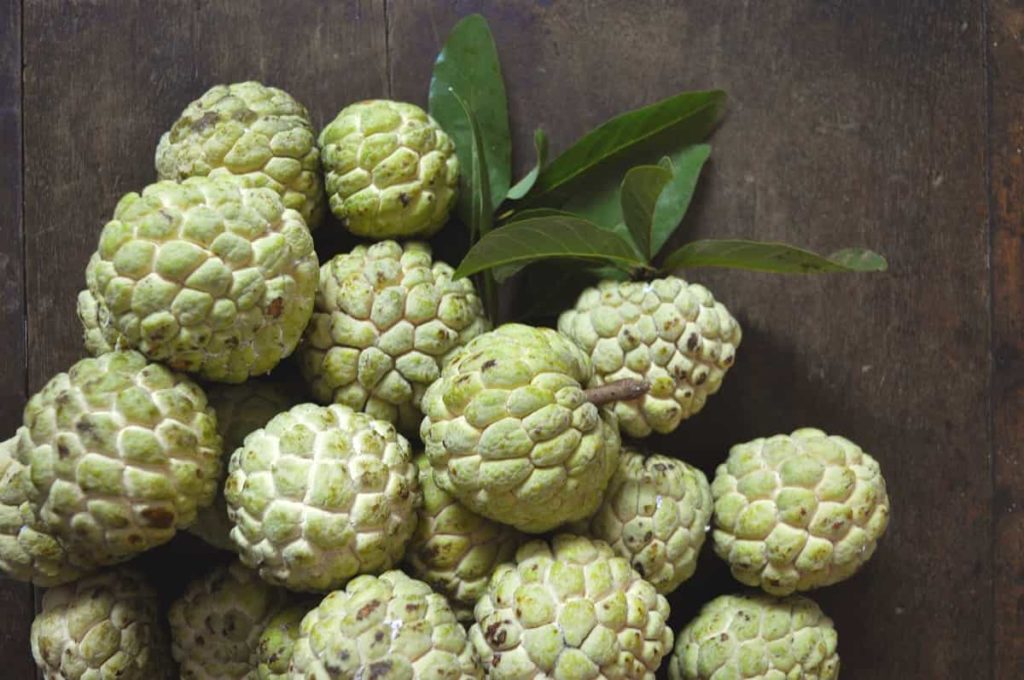
Step 16: Harvesting tips for getting more yield
The harvested Apple tree begins to bear fruit at the age of 3-4 years and decreases after 12-15 years. An average mature tree bears 100-180 fruits a year. Therefore, the timing of the harvest is essential. Also, not all fruits ripen simultaneously and the collection time varies depending on the variety and the weather conditions where they are grown. Visual methods based on skin color and fruit shape are commonly used today to decide when to harvest.
Another sign of ripening is the change in the seed color, which turns from light brown to almost black at the ripening stage. These criteria are generally unreliable in indicating proper maturity and are sometimes harvested before the fruit is ripe. Fruits should be pruned using scissors. Also, it should be cut in the morning. Custard Apple fruit is very delicate and should be cut with extra care.
- Types of Pesticides Used in Agriculture: A Beginner’s Guide
- Economical Aquaculture: A Guide to Low-Budget Fish Farming
- 15 Common Planting Errors That Can Doom Your Fruit Trees
- How to Make Houseplants Bushy: Effective Tips and Ideas
- Innovative Strategies for Boosting Coconut Pollination and Yield
- Pollination Strategies for Maximum Pumpkin Yield
- The Complete Guide to Chicken Fattening: Strategies for Maximum Growth
- Natural Solutions for Tulip Problems: 100% Effective Remedies for Leaf and Bulb-Related Issues
- Revolutionizing Citrus Preservation: Towards a Healthier, Greener Future
- Natural Solutions for Peony Leaf and Flower Problems: 100% Effective Remedies
- Maximizing Profits with Avocado Contract Farming in India: A Comprehensive Guide
- Natural Solutions for Hydrangea Problems: 100% Effective Remedies for Leaf and Flowers
- The Ultimate Guide to Choosing the Perfect Foliage Friend: Bringing Life Indoors
- From Sunlight to Sustainability: 15 Ways to Use Solar Technology in Agriculture
- The Ultimate Guide to Dong Tao Chicken: Exploring from History to Raising
- The Eco-Friendly Makeover: How to Convert Your Unused Swimming Pool into a Fish Pond
- Mastering the Art of Delaware Chicken Farming: Essentials for Healthy Backyard Flocks
- 20 Best Homemade Fertilizers for Money Plant: DIY Recipes and Application Methods
- How to Craft a Comprehensive Free-Range Chicken Farming Business Plan
- Brighten Your Flock: Raising Easter Egger Chickens for Beauty and Bounty
- How to Optimize Your Poultry Egg Farm Business Plan with These Strategies
- Subsidy for Spirulina Cultivation: How Indian Government Schemes Encouraging Spirulina Farmers
- Ultimate Guide to Raising Dominique Chickens: Breeding, Feeding, Egg-Production, and Care
- Mastering the Art of Raising Jersey Giant Chickens: Care, Feeding, and More
- Ultimate Guide to Raising Legbar Chickens: Breeding, Farming Practices, Diet, Egg-Production
- How to Raise Welsummer Chickens: A Comprehensive Guide for Beginners
- How to Protect Indoor Plants in Winter: A Comprehensive Guide
- Ultimate Guide to Grow Bag Gardening: Tips, Tricks, and Planting Ideas for Urban Gardeners
- Guide to Lotus Cultivation: How to Propagate, Plant, Grow, Care, Cost, and Profit
- Agriculture Drone Subsidy Scheme: Government Kisan Subsidy, License, and How to Apply Online
- Ultimate Guide to Raising Araucana Chickens: Breed Profile, Farming Economics, Diet, and Care
- Bringing Hydroponics to Classroom: Importance, Benefits of Learning for School Students
- Ultimate Guide to Raising Polish Chickens: Breed Profile, Farming Economics, Diet, and Care
- Ultimate Guide to Raising Australorp Chickens: Profile, Farming Economics, Egg Production, Diet, and Care
- Silkie Chicken Farming: Raising Practices, Varieties, Egg Production, Diet, and Care
- Sussex Chicken Farming: Raising Practices, Varieties, Egg Production, Diet and Care
Please provide me details to start a chicken farm in Sri Lanka and details of foods availability in sri lanka to start a farm